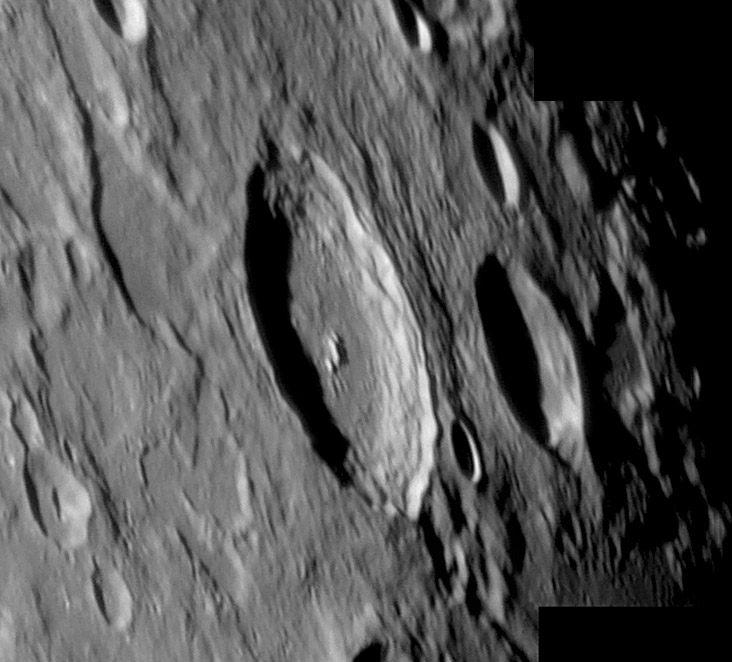LPOD June 23, 2008
AN OLDER TYCHO

image by François Emond
With a diameter of 86 km and an estimated depth of 4.8 km, Geminus is essentially the same size as Tycho. The central peaks of Geminus are more stubby than those of Tycho, its terraces are more rounded and subdued, and it lacks rays. All of this is due to aging by seismic shaking from subsequent impacts and a steady bombardment of small meteorites that round off sharp edges. Goodacre reported that Schmidt drew two rilles on the crater's floor, but this image and others (including Clementine) show that they do not, and never did, exist.
Chuck Wood
Technical Details
08/30/07; 02h11 UT. Dobson 16" + FFC Barlow lens + webcam Vesta Pro (B & W, raw mode) + red filter
Related Links
Rükl plate 16
François’ website
An earlier view
COMMENTS
To post comments regarding this LPOD you need to first register for the wiki by clicking the "Join this space" link under the Full Moon icon in the upper left corner of the screen, and wait for your membership to be approved. Once registered, you may still need to "Sign In" (link at top right of screen) to remove the "Protected" icon from the top of the LPOD page. Once you don't see a "Protected" icon, please click here and enter your comment in the space below. Please do not edit the LPOD itself!
1. OK, just to tell you, Moonlovers, my Moon movement between Slovenian astrophotographers is making great progress - look at these shots - Peter Oberč - riverpoet is the author and owner of the site. Wait till he starts for real, becouse he is still just waiting for the Moon to set, so he can go deep-sky diving ;) -- Aleksander Božič aka SandiBandi
2. Chuck, I wonder if the descriptions of Schmidt's rilles might have gotten a little garbled. Elger's descriptions of what sound like closely-related features (as quoted on the Geminus page) are so vivid and detailed it's hard to imagine they were entirely imaginary. The rille he describes as running over the southeast wall and striking out across the surrounding plain is almost certainly the graben-like feature that was adopted into the original IAU nomenclature as Rima Burckhardt I. Although that name appears to have have been dropped, the feature continues to exist. A little piece of the two channels is clearly visible below Geminus in François' image (running towards the black rectangle); and with a little imagination it can be seen continuing across onto the inner wall of Geminus. I would assume that is what Elger is describing, although in higher sun images I have trouble seeing any extension of it onto the floor; nor can I see the similar-looking rille he says is symmetrically placed in the north (although again, I can imagine a slight crease running across the wall in the upper left). One problem is that the descriptions in Named Lunar Formations place Schmidt's Geminus rilles just inside the SW and NE walls (in the modern E-W convention) -- which seems opposite to the two positions I just described (perhaps Mary Blagg had as much trouble with east and west as I do). But rilles being as elusive as they are, I would hesitate to be sure there are no traces of these faults on the main crater floor without looking at more images at a wider variety of sun angles and azimuths. - Jim Mosher